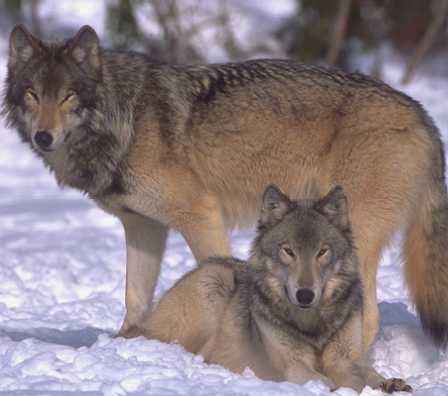USFWS Proposes Returning Management of Gray Wolves to States
OutdoorHub Reporters 06.07.13

The U.S. Fish and Wildlife Service (USFWS) proposed earlier today to remove the gray wolf from the list of threatened and endangered species. The decision would once again return control of the species to state wildlife agencies.
Several states in the Great Lakes and Northern Rocky Mountain regions have already regained management of the gray wolf, as the population in these areas exceeds recovery goals by as much as 300 percent. The species was delisted in specific jurisdictions in 2011 and 2012, and since then the areas have seen successful management hunts.
Protections offered by the endangered species list will still be in effect for the Mexican wolf, a threatened subspecies of the gray wolf in parts of the Southwest.
The gray wolf has come far since it balanced on the knife’s edge of extinction in the 1930s. Conservationists began reintroducing the species to their previous ranges, using wolves transported from Alaska and Canada, in the hope of allowing the wolf to reclaim their native habitat. While the gray wolf only roams a fraction of the range it used to, biologists say the recovery effort has been widely successful. Today, there is an estimated 6,100 gray wolves in the Lower 48 states while 7,000 to 11,000 reside in Alaska. To reach this mark from a bare handful is being heralded by some as an astounding achievement.
“From the moment a species requires the protection of the Endangered Species Act, our goal is to work with our partners to address the threats it faces and ensure its recovery,” said Service Director Dan Ashe. “An exhaustive review of the latest scientific and taxonomic information shows that we have accomplished that goal with the gray wolf, allowing us to focus our work under the ESA on recovery of the Mexican wolf subspecies in the Southwest.”
The end goal of putting a species on the endangered species list is to one day being able to take it off. In that regard, the USFWS argues that the gray wolf has significantly recovered and no longer requires federal protection. This decision is supported by state wildlife departments and a number of hunting and conservation groups.
“The Washington Department of Fish and Wildlife is firmly committed to the long-term persistence of wolves in Washington,” said Miranda Wecker, Chair of the Washington Fish and Wildlife Commission. “The Washington Fish and Wildlife Commission believes the state should be responsible for the management of wolves and supports the U.S. Fish and Wildlife Service’s consideration of delisting gray wolves under the federal Endangered Species Act.”
Craig Kauffman, president of Safari Club International (SCI), also supported the measure and applauded the Service’s use of scientific analysis in coming to their decision.
“SCI’s leadership recently met with the USFWS, and we had a robust discussion on the delisting potential of wolves,” he said. “We hope to continue to work with the Service and to defend their efforts to delist recovered species.”
However, some animal rights groups believe that the wolf population is still too vulnerable to be delisted. Immediately after the USFWS made the announcement, Defenders of Wildlife (DOW) released a statement that called the proposal “irresponsible” and began a petition to collect 230,000 signatures demanding the wolves not be removed from the list.
“We are providing the expert ESA policy and legal analysis that clearly shows that this delisting is premature, and would set a dangerous precedent for other endangered animals,” read a statement on DOW’s website.
Animal rights organizations have long been fencing-off with wildlife agencies on the management of gray wolves. With the growing number of wolves in many states, conflicts with humans have become increasingly common. In addition to preying on game animals like deer, wolves also target cattle and sometimes pets. This puts the wolves at odds with farmers and residents of areas with a high wolf population. Wildlife departments propose that management hunts will keep the wolf population under control.
“The Fish and Wildlife Service understands that the state agencies and states where the wolves are have the capacity to manage wolves along with all other game species,” SCI’s Nelson Freeman told OutdoorHub. “As the population increases, state agencies will have the ability to handle the entire process of management at that time.”
When the proposal to delist the species first surfaced nearly two months ago, the long debate flared up once more. Late last month the USFWS delayed the proposal without explanation. Now, it appears that the Service is back on track to return the fate of the wolves back to state hands. Following the proposal the USFWS is holding a 90-day comment period which will review information submitted to it by the public. You can learn more about providing comments here.

